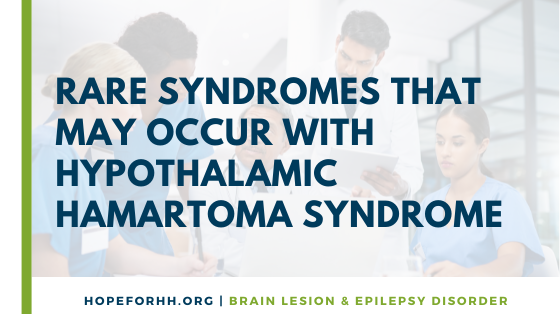
Rare Syndromes That May Occur With Hypothalamic Hamartoma Syndrome
A syndrome is defined by a large group of symptoms and/or other conditions that consistently occur together. Hypothalamic Hamartomas have become known as a rare syndrome, based on consistent comorbidities (symptoms and/or syndromes that consistently occur together) of epilepsy, endocrine dysfunction, as well as cognitive and behavior challenges. Hypothalamic Hamartoma Syndrome is such a broad spectrum disorder, that it often encompasses other rare syndromes and conditions as a part of the disorder. These include Central Precocious Puberty (CPP), Lennox-Gastaut Syndrome (LGS), Pallister-Hall Syndrome (PHS), and Prader Willi Syndrome (PWS)(acquired).
Central Precocious Puberty (CPP)
Central Precocious Puberty occurs in approximately 40% of children with HH. Precocious puberty is early onset of puberty, typically before the age of 8 in girls and 9 in boys. Puberty is triggered due to damage to the hypothalamus and/or the pituitary stalk, either by the tumor itself or from injury during surgical treatment. The result is the release of gonadotropin-releasing hormone, which then communicates to the pituitary gland to release the follicle-stimulating hormone (FSH) and luteinizing hormone (LH). These hormones are responsible for the observable biological markers in puberty. For example, children may begin to have pubic hair, body odor, acne, grow abnormally fast with height and weight, as well as begin menses and breast growth (girls) and developed genitals and erections (boys). In infants with hypothalamic hamartomas, these symptoms can begin to develop as early as infancy. To read more about CPP, please visit Hypothalamic hamartoma with epilepsy: Review of endocrine comorbidity (nih.gov)
Lennox-Gastaut Syndrome (LGS)
Lennox-Gastaut Syndrome is a form of severe epilepsy that typically begins between the ages of 3-5 years old. The condition starts from a more simple epilepsy with one seizure type, and then it develops over time into a more severe epilepsy with multiple seizure types. LGS is a developmental brain disorder causing developmental delays/intellectual disability, behavior challenges, and EEG abnormalities, such as slow spike-and-wave (SSW) or generalized paroxysmal fast activity (GPFA). Seizures are frequent, intense and debilitating and most often resistant to medication management which results in the seizures becoming more intense and further impacting development and behavior. There is no cure for LGS and 85% of children diagnosed will continue to have significant seizures into adulthood. Approximately 50% of children with LGS will experience difficulties with communication, balance, behavior, sleep, rage aggression, and characteristics of autism. It is thought that approximately 14% of individuals with HH may also have a diagnosis of LGS. To read more about LGS, please visit Lennox-Gastaut syndrome | Genetic and Rare Diseases Information Center (GARD) – an NCATS Program (nih.gov)
Pallister-Hall Syndrome (PHS)
Pallister-Hall Syndrome is a rare genetic condition with a significantly wide range of characteristics that most frequently includes abnormal development of extremities, such as: extra fingers and/or toes (polydactyly); fusion of fingers and/or toes; and improper development of the nails. The condition also may include these additional common features: abnormal division of the epiglottis; hypothalamic hamartoma; decreased pituitary function; and a condition in which a thin covering blocks the anal opening or the passage that normally connects the anus and the lowest part of the large intestine fails to develop. The condition may also present with a number of minor characteristics (e.g. missing teeth, short limbs, facial features, etc..). PHS is genetically inherited in an autosomal dominant pattern and is caused by mutations in the GLI3 gene. PHS is extremely rare with approximately 100 patients reported in the medical literature from 1980-2001. Approximately 5% of all HH cases have PHS. To read more about PHS, please visit Pallister-Hall syndrome | Genetic and Rare Diseases Information Center (GARD) – an NCATS Program (nih.gov)
Acquired Prader-Willi Syndrome (PWS)
Prader-Willi Syndrome (PWS) is a rare genetic condition that is not usually inherited, as it tends to occur randomly. The condition is most known for hyperphagia, or the constant need to eat because the individual never feels full. The condition also results in physical, mental, and behavioral characteristics. Specifically, individuals may have distinct facial features, poor muscle tone, underdeveloped sex organs, and poor growth/physical development. With regards to mental and behavioral characteristics, an individual may have delayed motor and speech, cognitive impairment, poor frustration tolerance, obsessive/repetitive behaviors, and sleep disorders. Because the individual has difficulty regulating when they are full, behavior challenges are often related to food and overeating leads to the individual’s obesity. For individuals with HH that have undergone some form of ablative/resective surgery, appetite control can be an issue. This is usually a result of damage or insult to the hypothalamus (which can also occur from the tumor itself before surgery, if the tumor is unusually large). In these cases, it is sometimes referred to as “Acquired Prader-Willi Syndrome.” To read more about PWS, please visit Prader-Willi syndrome | Genetic and Rare Diseases Information Center (GARD) – an NCATS Program (nih.gov)
CPP, LGS, PHS, and PWS are syndromes that may be comorbid (or go together) with the HH Syndrome. However, if an individual is diagnosed with one of these syndromes, it does not mean that the individual also has an HH. Further, these syndromes are not the only comorbidities that may or may not follow along with a diagnosis of HH. For a more complete list of HH symptoms and comorbidities, please visit:
Additional Resources:
- Comorbidities and HH
- Hypothalamic Hamartomas – Psychiatric Behaviors, Conditions, and Personality Characteristics
- Hypothalamic Hamartomas – Top Endocrine Conditions and Symptoms
- Hypothalamic Hamartomas – Top Cognitive Issues
*see reference https://n.neurology.org/content/78/1_Supplement/P01.067





